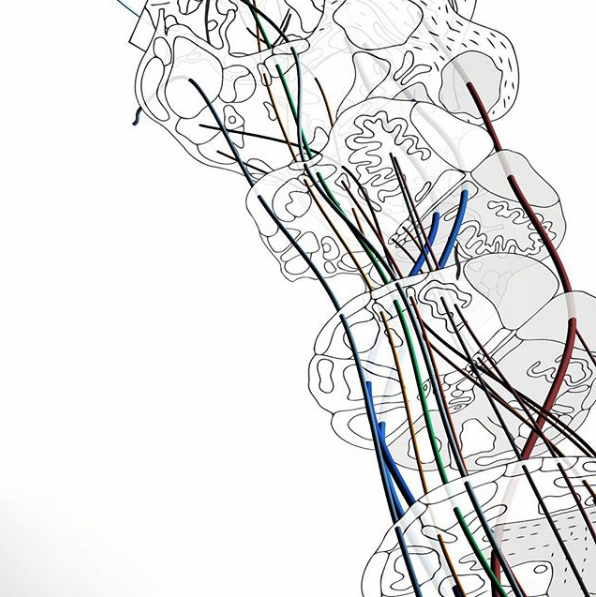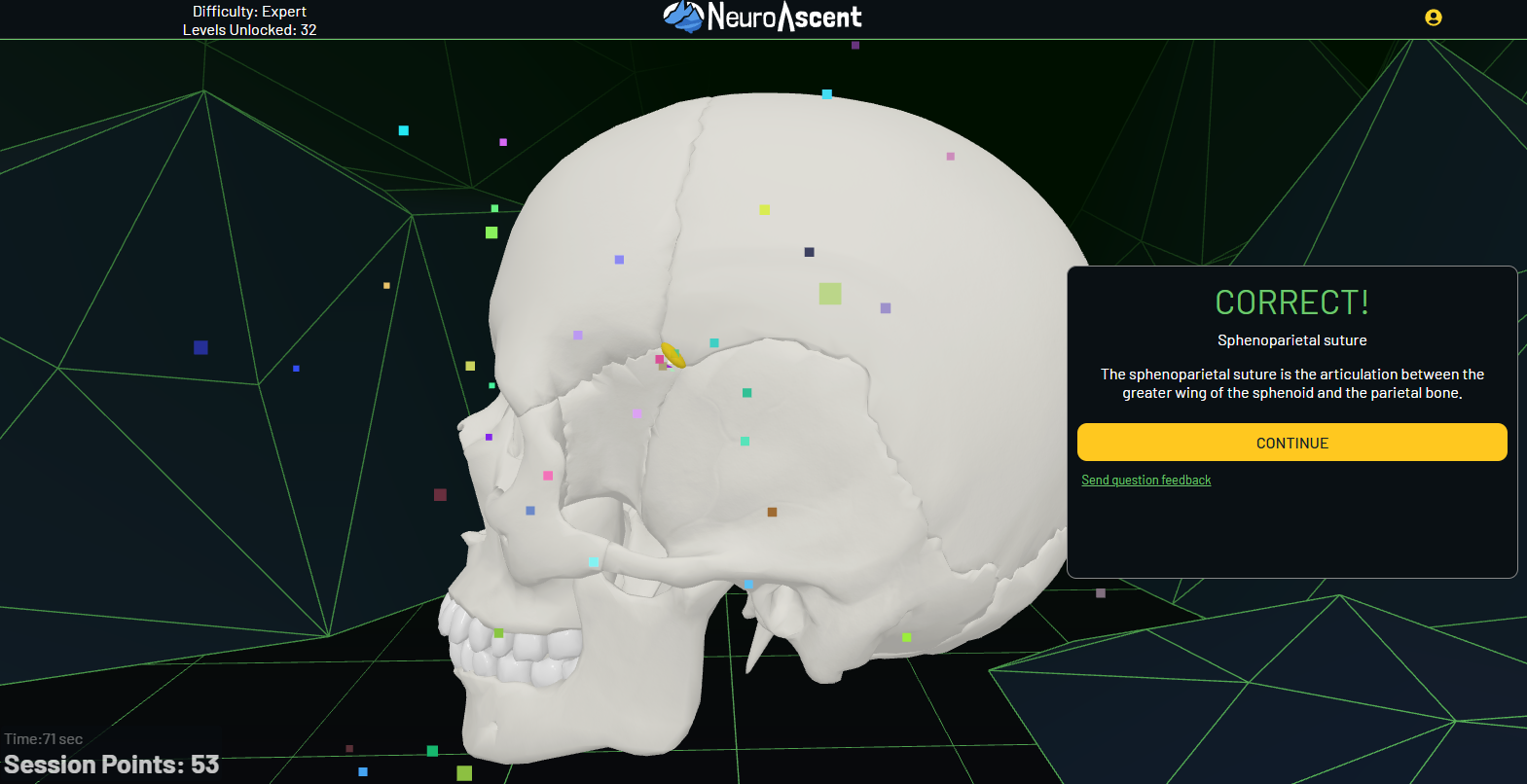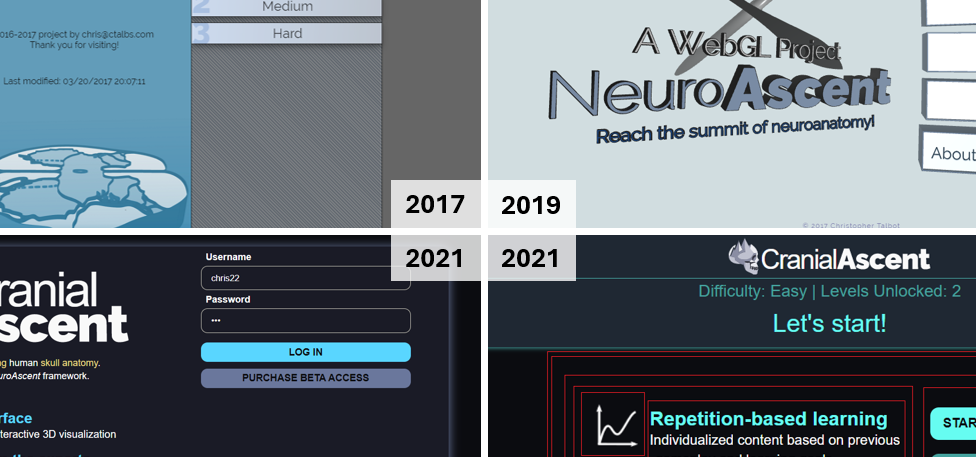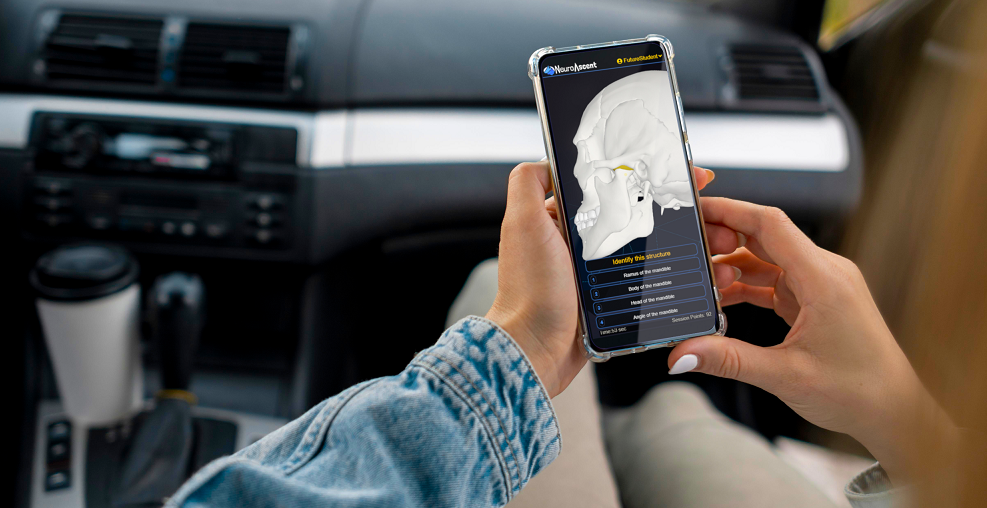Medical students consistently rank neuroanatomy among the most challenging subjects in their education. In fact, the term “neurophobia” emerged to describe the widespread anxiety this complexity creates among students and healthcare providers. For those about to begin their neuroanatomy journey, this article provides a brief overview of this challenging yet rewarding field.
About Neuroanatomy
The human nervous system, perhaps our most intricate organ system, should be understood through different sized perspectives from individual cells to interconnected organs. It is by this approach to the anatomy by which the physiology of the nervous system is mastered. At the cellular level, neurons and their supporting cells form the foundation of neural tissue. These cells organize into tissues like white matter (myelinated axon tracts) and grey matter (neuronal cell bodies and dendrites). Collections of tissues, including supporting connective tissue and vasculature, give rise to complex structures and organs such as nerves, the spinal cord, and the brain.
The nervous system divides into two major components: the central nervous system (CNS) and the peripheral nervous system (PNS). The CNS, comprising the brain, brainstem, cerebellum, and spinal cord, serves as the command center. Here, complex neural circuits process information and coordinate responses, orchestrating functions from conscious thoughts to unconscious regulation of vital processes. The PNS extends throughout the body through an extensive network of nerves, including twelve pairs of cranial nerves. These peripheral nerves, classified by their targets (somatic or visceral) and signal direction (efferent/motor or afferent/sensory), form crucial communication channels between the CNS and body tissues.
Understanding neuroanatomy requires knowledge across multiple disciplines. Histology reveals cellular organization, physiology explains functional relationships, and molecular biology uncovers the mechanisms of neural signaling. Through these perspectives, neuroanatomy illuminates the pathways underlying everything from basic reflexes to complex cognitive processes, providing healthcare providers with essential knowledge for understanding both normal function and pathological conditions.
Who Needs to Study Neuroanatomy?
If you’re diving into the world of healthcare, learning and applying the basics of neuroanatomy is essential in recognition and management of neurological illnesses such as stroke, Parkinson’s disease, epilepsy, and many other conditions. Many healthcare professionals benefit from studying neuroanatomy as it plays a crucial role in their understanding, diagnosis, and management of neurological diseases and conditions. These professions include:
- Physicians and surgeons (MD, DO)
- Advanced practice providers (PA, NP)
- Nurses
- Dentists and dental hygienists
- Chiropractors
- Physical and occupational therapists
- Neuroscientists (MS and PhD)
- Psychologists
- Speech, language, and swallow therapists
The basics of neuroanatomy are essential for these healthcare disciplines to provide effective care. The elegance of neuroanatomy is best exemplified by the neurological exam which can be performed by any of these professions. Exam findings can be incredibly precise and serve as a compass guiding you toward the location of the lesion or problem afflicting the nervous system. Physicians, surgeons, and neuroscientists arguably demand the highest level of neuroanatomical expertise. Students, residents, and other trainees undergo a rigorous curriculum of medical neuroanatomy, neurology, neuropathology, neuropharmacology, neuroradiology, and many other subspecialized topics.
Traditional medical students undergo an intensive 2–3-month curriculum in neuroanatomy and neurology within the initial years of school. This prepares them for the challenges of early identification and appropriate management of neurological conditions such as dementia, stroke, seizures, and psychiatric illness. Neurology and neuroanatomy topics are also often tested in medical board exams such as the USMLE and COMLEX.
This knowledge is not confined to neurologists alone; professionals across diverse specialties, including family medicine, emergency medicine, and internal medicine, benefit from a familiarity with neurological illnesses for timely identification and basic management.
Why Neuroanatomy?
Delving into the intricacies of neuroanatomy can be challenging due to its complex terminology. This exploration goes beyond textbooks, offering a gateway to decoding the intricate language of neurons, neurotransmitters, and the neural pathways that shape our every thought, action, and sensation.
The knowledge acquired through neuroanatomy is not merely theoretical; it forms an indispensable toolkit for healthcare professionals. This knowledge isn’t just interesting; it’s essential. Why? Because it forms the backbone for diagnosing and treating neurological disorders, those complex puzzles that challenge our well-being. The clinical diagnosis of these conditions sometimes starts with a doctor finding certain signs or deficits on physical exam. Changes such as muscular weakness, numbness, and abnormal eye movements can localize to very specific locations in the nervous system. A healthcare provider can then order specific imaging to confirm findings and secure a diagnosis!
Imagine being equipped with the ability to decipher the neural pathways, the highways of information in our brain, through just meeting and examining a patient. This understanding is a game-changer, contributing significantly to the leaps and bounds we make in healthcare. From pinpointing the root of disorders to developing effective treatments, neuroanatomy empowers healthcare professionals to select the best follow up studies such as CT imaging, MRI, EEG, and/or nerve conduction studies.
The need for better neuroanatomy education and neurology care is ever increasing. According to the World Health Organization (WHO), millions of people across the world suffer from neurological disorders. The most popular ones are Alzheimer’s, epilepsy, and stroke. About 6.8 million people die from neurological disorders every year. In essence, embracing neuroanatomy is not just about studying structures; it’s about gaining the insights that empower us to decipher the intricate workings of the nervous system, fostering progress in the realm of medical science and the quality of care provided.
How Students Study Neuroanatomy
Navigating the intricacies of neuroanatomy requires students to embark on a multifaceted learning journey that combines various approaches. This complex field demands a comprehensive understanding, and students employ a combination of lectures, textbooks, atlases, dissections, and hands-on laboratory work to grasp its nuances.
In the classroom, lectures are the starting point. They go hand-in-hand with textbooks and anatomical atlases. During lectures, students learn the basic theories, exploring how the nervous system is structured and how it functions. These lessons build a foundational understanding that is essential for the more hands-on parts of studying neuroanatomy that come later.
Hands-on laboratory work forms a pivotal component of neuroanatomy studies. Engaging with cadaveric specimens allows students to bridge the gap between theory and reality. The experience of dissecting and exploring the intricacies of the nervous system in a controlled environment helps to enhance their understanding. It’s a direct and tangible connection to the anatomical structures they’ve studied in textbooks and lectures. Many students report the importance of this experience in the solidification of their knowledge. Unfortunately, the maintenance of cadaveric labs and specimens is expensive. Many medical schools have reduced the amount of lab dissection performed by their students.
Macroscopic and microscopic perspectives are equally crucial in the study of neuroanatomy. At the macroscopic level, the central nervous system unfolds as a three-dimensional marvel, presenting intricate surface anatomy that often appears daunting. On the other hand, the microscopic perspective offers a deep dive into the minute details of neuroanatomy. Here, students examine the cellular and molecular structures that make up the nervous system. This includes studying neurons, their synapses, and various types of neural tissues. Understanding these tiny components is essential, as they play a significant role in the overall functioning and pathology of the nervous system. It’s like looking under a magnifying glass to see the intricate workings that are invisible to the naked eye.
Gross observations delve into the elaborate patterns formed by sulci and gyri in the cortex, the configurations of ascending and descending pathways in the brainstem, and the intricate weaving of structures like the brachial plexus. To unravel this complexity, students employ a variety of tools for macroscopic observation, including cadaveric specimens, dissections, plastic models depicting the central nervous system, as well as visual aids like photos and illustrations. These tangible resources bridge the gap between theoretical knowledge and the tangible reality of the nervous system’s intricate structure.
However, to truly grasp the detailed intricacies, students also delve into the microscopic realm. Neuroanatomy is often studied through 2-dimensional microscopic slices, revealing a figurative stacking of images much like floors in a tall building. This approach offers a nuanced perspective, allowing students to explore the intricacies of the nervous system layer by layer. These microscopic views provide insights into the cellular architecture of the nervous system, reinforcing the connection between structure and function. The study of axial, horizontal, sagittal, and coronal sections also offer a layered understanding, much like navigating different floors in a building.
This comprehensive understanding, achieved through both broad observations and detailed examinations, equips students with a profound insight into the fascinating world of neuroanatomy.
Tools Used in Neuroanatomy Study
To dive into the fascinating world of neuroanatomy, students require a diverse set of tools that extend past the usual study materials. This complex area of study demands a range of resources, each playing a part in building a comprehensive understanding of the nervous system.
- Textbooks and Anatomical Atlases: These serve as the foundational guides, offering comprehensive explanations and visual representations of neuroanatomy. Textbooks delve into theoretical concepts, while anatomical atlases provide detailed illustrations, aiding students in visualizing intricate neurosurgical structures and their spatial relationships.
- Digital Tools: In today’s tech-savvy world, digital resources are key. Tools like virtual dissection software and educational apps make learning neuroanatomy interactive and engaging. These digital options enable students to virtually delve into the complexities of the nervous system, offering immersive experiences that boost their understanding.
- Cadaveric Specimens: The tactile experience of working with cadaveric specimens is unparalleled. It provides students with a direct encounter with the physical reality of the nervous system. Dissecting cadavers allows for a hands-on exploration, bridging the gap between theoretical knowledge and the tangible structures within the human body.
- Plastic Models: Complementing cadaveric specimens, plastic models offer a more controlled and repeatable learning experience. These models provide a three-dimensional representation of the central nervous system, enabling students to manipulate and study anatomical structures in a structured environment.
- Basic Biology and Anatomy Foundation: Before diving into the intricacies of neuroanatomy, students benefit from a solid foundation in basic biology and anatomy. Understanding the broader context of human biology lays the groundwork for comprehending the specialized structures and functions of the nervous system.
- Interactive Workshops, Conferences, and Demonstrations: Hands-on experiences in the form of workshops and demonstrations further enriches the learning process. These sessions, guided by experienced educators, offer opportunities for direct interaction with anatomical specimens and reinforce theoretical knowledge through practical application.
- Collaborative Learning Platforms: Engaging with peers through collaborative learning platforms fosters discussion and knowledge exchange. Group study sessions, online forums, and interactive discussions provide avenues for clarifying doubts, sharing insights, and gaining diverse perspectives on neuroanatomy concepts.
- Anatomical Imaging Techniques: Advancements in imaging techniques, such as MRI and CT scans, offer non-invasive ways to visualize the living nervous system. Understanding these techniques provides students with insights into both normal anatomy and pathological conditions.
- Clinical Correlation Sessions: These sessions are the final piece of the puzzle in mastering neuroanatomy. By linking the study of neuroanatomy to real-life clinical situations using case studies and actual examples, they highlight the subject’s practical importance. These sessions serve as a crucial bridge, connecting academic knowledge with its real-world use in diagnosing and treating neurological disorders. They complete the learning journey, ensuring a well-rounded understanding of neuroanatomy in both theory and practice.
By leveraging this diverse toolkit, students can immerse themselves in the multifaceted world of neuroanatomy, gaining a comprehensive and nuanced understanding of the intricate structures and functions of the nervous system.
Conclusion
In summary, for those of you venturing into the world of medicine, diving into neuroanatomy is both challenging and incredibly rewarding. This article has shed light on the intricate nature of this field, highlighting how crucial it is for understanding the complex language of the nervous system. Remember, neuroanatomy isn’t just a subject; it’s the bedrock for healthcare professionals navigating the fascinating and intricate world of bodily functions.
As students embark on this journey, you’re armed with an array of tools. From engaging with real cadavers to flipping through textbooks and exploring digital resources, each element helps you navigate the mesmerizing landscape of neuroanatomy. This toolkit isn’t just for learning; it’s your compass in the exploration of this captivating field.
Remember, studying neuroanatomy goes beyond academic goals. It’s a commitment to deciphering the secrets that control our health. To the future medical heroes out there, embrace these challenges. They’re your gateway to advancing medical science and enhancing human well-being. So, to all you neuroanatomy explorers, keep in mind that every layer you uncover and every pathway you map out is a step towards making a significant impact in the world of neurological health. Keep pushing forward—the journey itself is just as valuable as the destination. Let’s embark on this adventure together! 🧠💪🌟
References
Hall, S., Stephens, J., Parton, W., Myers, M., Harrison, C., Elmansouri, A., Lowry, A. and Border, S. (2018). Identifying Medical Student Perceptions on the Difficulty of Learning Different Topics of the Undergraduate Anatomy Curriculum. Medical Science Educator, [online] 28(3), pp.469–472. doi:https://doi.org/10.1007/s40670-018-0572-z.
Qamar, K., Bashir, S., Khalid, R., Mehwish Abaid and Rehana Khadim (2021). REASONS FOR DIFFICULT TOPICS IN ANATOMY AND THEIR SOLUTIONS AS PER UNDERGRADUATE MEDICAL STUDENTS. Khyber Medical University Journal, 13(3), pp.161–165. doi:https://doi.org/10.35845/kmuj.2021.21177.
World Health Organization (2007). Neurological disorders affect millions globally: WHO report. [online] www.who.int. Available at: https://www.who.int/news/item/27-02-2007-neurological-disorders-affect-millions-globally-who-report.



